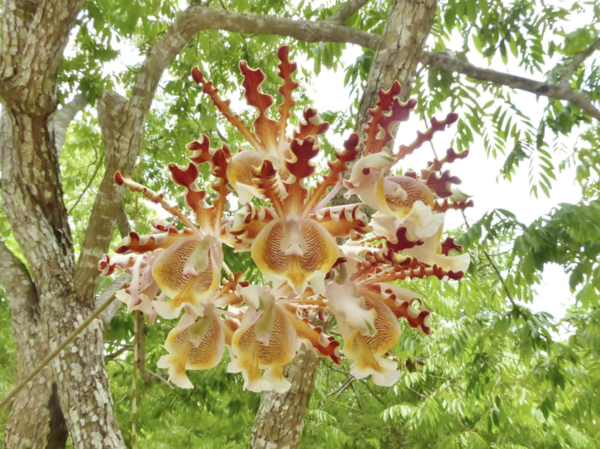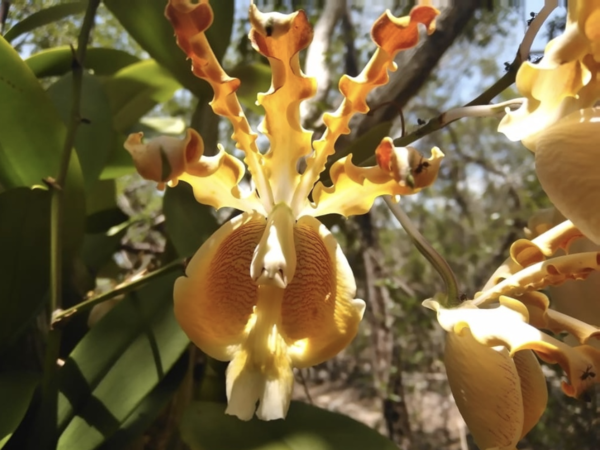Myrmecophila christinae is a unique and fascinating species of orchid renowned for its symbiotic relationship with ants and its strikingly beautiful flowers. This tropical epiphyte belongs to the Orchidaceae family and thrives in specific ecological niches. In this guide, we’ll explore everything you need to know about this orchid, from its taxonomy and habitat to cultivation and care. Whether you’re an orchid enthusiast or a beginner, this article is designed to provide detailed insights while optimizing for search engines.

Scientific Name: Myrmecophila christinae
Family: Orchidaceae
Subfamily: Epidendroideae
Tribe: Laeliinae
Common Name: Christina’s Ant Orchid
Myrmecophila christinae is part of the Myrmecophila genus, a group of orchids well-known for their mutualistic relationships with ants. The genus name "Myrmecophila" originates from the Greek words "myrmex" (ant) and "philos" (lover), highlighting the plant's association with ants.
This orchid species is native to Central America and certain parts of the Caribbean, where it grows in coastal lowlands and tropical forests. It typically inhabits regions with warm climates, thriving in areas with high humidity and abundant sunlight.
Myrmecophila christinae grows as an epiphyte on trees, deriving support but not nutrients from its host. What sets this species apart is its unique relationship with ants. The orchid develops hollow pseudobulbs, which serve as shelters for ant colonies. In return, the ants provide protection against herbivores and fertilize the plant with their waste, creating a perfect example of mutualism.
Climate: Tropical, with temperatures ranging from 20–30°C (68–86°F).
Elevation: Found mostly at low altitudes, below 500 meters (1,640 feet).
Light Requirements: Prefers bright, indirect sunlight.
Myrmecophila christinae is a striking orchid with several distinctive features:
Pseudobulbs: Large, hollow, and cylindrical structures that house ant colonies.
Leaves: Thick, fleshy, and succulent, adapted to retain water in dry periods.
Flowers: The orchid produces long, branching flower spikes that can reach up to 2 meters (6.5 feet) in length. The flowers are fragrant, vibrant, and typically range from pink to purple, with intricate markings on the lip.
The blooming season varies depending on the environment but typically occurs during the warmer months.

Successfully growing Myrmecophila christinae requires replicating its natural habitat. Here are some key factors to consider:
This orchid thrives in bright, indirect sunlight. In cultivation, it can handle direct morning light but should be shielded from the intense midday sun to prevent leaf burn. If grown indoors, place it near a south-facing window or under grow lights.
Optimal Temperature: 20–30°C (68–86°F).
Humidity: Requires 60–80% humidity to mimic its tropical environment. Use a humidifier or place a tray of water near the plant if grown indoors.
Water thoroughly but allow the medium to dry out between waterings. During the growing season (spring and summer), water more frequently, and reduce watering in winter when the plant enters dormancy.
Use a well-draining epiphytic orchid mix, such as bark, sphagnum moss, or perlite. Mounting the orchid on a piece of wood or cork bark can also mimic its natural epiphytic growth.
Feed with a balanced orchid fertilizer (e.g., 20-20-20) diluted to half strength every two weeks during the growing season. Reduce fertilization during dormancy.
Repot every 2–3 years or when the plant outgrows its container. Be cautious of the ant colonies when handling the plant, as disturbing them can stress the orchid.
Myrmecophila christinae is typically propagated through division. When dividing the plant, ensure each section has at least two pseudobulbs and a healthy root system. Propagation should be done during the active growing season to ensure success.

While the plant benefits from its relationship with ants, it can still face challenges:
Common Pests: Spider mites, scale, and aphids.
Diseases: Root rot due to overwatering and fungal infections in poorly ventilated conditions.
Ensure proper airflow and avoid overwatering to minimize these risks.
Due to habitat loss and over-collection, some populations of Myrmecophila christinae may face threats in the wild. Sustainable cultivation practices and conservation efforts are crucial to preserving this species.
Myrmecophila christinae is not just another orchid—it’s a marvel of evolution. Its partnership with ants demonstrates nature’s ingenuity in creating mutually beneficial relationships. For orchid enthusiasts, this species offers a unique combination of beauty, ecological intrigue, and a fascinating story of co-evolution.
Myrmecophila christinae is a captivating orchid that deserves a special place in any collection. Its stunning flowers, symbiotic relationship with ants, and adaptability make it a rewarding plant to grow. With proper care and attention, this rare orchid can thrive in cultivation, bringing a touch of tropical elegance to your home or garden.
By understanding its needs and respecting its ecological role, you can enjoy the beauty of Myrmecophila christinae while contributing to the preservation of this extraordinary species.
animal tags: Myrmecophila-christinae
We created this article in conjunction with AI technology, then made sure it was fact-checked and edited by a Animals Top editor.